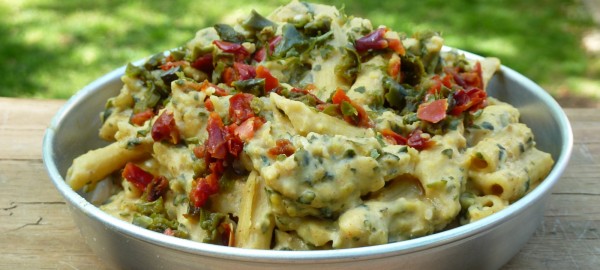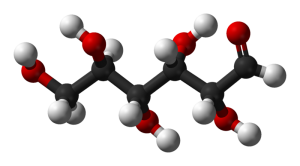
Food is a mixture of nutrients that produce energy for the body, stimulate growth, and maintain life. The six classes of nutrients:
- Carbohydrates
- Protein
- Fats
- Vitamins
- Minerals
- Water
Of these six nutrients, only the first 3 provide calories in the form of energy for the body: carbohydrates, protein, and fat.
- 1 gram of carbohydrate = 4 calories
- 1 gram of protein = 4 calories
- 1 gram of fat = 9 calories
Backpacking in mountainous terrain can burn 4,000 to 5,000 calories per day. If fat makes up more than the combined calories of a protein and carbohydrate, why not just focus on eating fat?
Most sources agree that carbohydrates should make up the bulk of your calories, followed by fat and protein.
Why carbohydrate calories are important

Carbohydrates are an essential macronutrient to over-consume when it comes to backpacking (or any form of endurance activity) because the primary purpose of carbohydrates is to provide energy. Carbs break down into glucose for immediate energy needs, and the surplus gets stored as glycogen for future energy needs. Once glycogen stores get filled, the remaining calories get converted into fat.
The type of carbohydrates consumed is important. There are two types of carbohydrates – complex and simple.
- Simple carbs (sugar) provide a quick burst of energy. Examples: candy bars, energy bars, baked goods, ice cream, candy, and sugary drinks.
- Complex carbs (starches) provide sustained energy. Examples – whole grain pasta/bread, barley, millet, brown rice, oats, quinoa, buckwheat, vegetables, beans, lentils.
Backpackers should focus primarily on complex carbohydrates. Complex carbohydrates are the body’s best source of energy. They are broken down into glucose more slowly than simple carbohydrates. Thus, they’ll provide a sustained and gradual caloric release.
Why are carbs maligned if they are so essential for energy? Because of simple carbs, not complex carbs. Confusion arose when the word “simple” was dropped, making it seem all carbohydrates (including complex) were terrible.
Why fat calories are important
The body depends on burning calories from fat (lipids) once it burns through calories from carbohydrates. Fat serves as the storage substance for the body’s extra calories. We seem to have an unlimited storage capacity for fat, making it our largest energy reserve. Yet, fat is slow to digest and does not convert into quick energy. That is because the primary purpose of fat is to provide cell structure, a process that requires breaking down the fat and transporting it to cells. This process can take several hours. This is why it is essential to have a reserve of fat cells available much before an activity rather than relying on them as a quick energy source.
Fat is also necessary for :
- Helping you absorb vitamins in your food (vitamins A, D, E, and K).
- Increasing satiety, the feeling that you have eaten enough.
- Reducing the glycemic impact of food so your blood sugar doesn’t spike and crash (leaving you tired).
- Helping you stay warm by insulting and cushioning vital organs in the body.
There are two types of fat – saturated and unsaturated. Saturated fats are primarily from animal origins and unsaturated from plant sources.
Since fat provides 9 calories per gram, hikers need to consume a higher amount of fat to make up for lost calories. We suggest gradually adding an extra amount of fat to the diet and focusing predominately on non-animal (unsaturated) sources to prevent arterial clogging and strain on the heart. Reliable and healthy high-fat sources include those from plants, such as nuts, seeds, coconut, and olive oil. See the list of vegetarian fats.
What about protein?
Recall that the calories per weight are the same for protein as for a carbohydrate (1 gram equates to 4 calories). However, this is somewhat misleading as only some (or none) of the amino acids from protein are usable for fuel. Protein does not serve as an energy source. In fact, protein will only be used as a fuel when carbohydrates and fat storage are inadequate. The primary role of protein is in the construction of DNA cells. Protein is an essential nutrient for maintaining muscles, bone, skin, hair, and other tissues. Failing to take in adequate carbohydrates will require the body to use protein as an energy source, limiting your ability to maintain muscle and tissue.
There is a common misconception that we need a lot of protein – in fact, only 1 in 10 calories should come from protein.* The problem is that most people get too much protein. Any excess protein not needed for cell maintenance is excreted from the bowels. A diet relying on animal products is unnecessary, especially when eaten in high amounts, as it is directly wasted. This also applies to high protein plant-based sources as well – such as soybeans. The protein fixation – even for vegans – is unwarranted. If you eat a diet that incorporates a substantial amount of grains/legumes and a fair amount of nuts/seeds, you will get adequate protein. Protein is in almost every food except sugar, alcohol, and fats. Relying on protein as a fuel is a bad idea—more information on the protein myth by the Physicians Committee for Responsible Medicine (PCRM). Read more from Wikipedia about how proteins work as a nutrient.
Vitamins & Minerals
Except for sugar, almost all foods consumed contain essential minerals. Minerals help the body produce chemical reactions. These include iron, calcium, phosphorus, sodium, potassium, iodine, magnesium, zinc, and copper.
Fat-soluble vitamins
The four fat-soluble vitamins include A, D, E, and K. They require body fat (lipids) to be absorbed into the body and can be stored in body tissue for long periods. Taking too much of these vitamins can result in having too much of these vitamins present in the body, leading to hypervitaminosis.
Each vitamin has a specific role:
- Vitamin A is needed for strong bones, good vision, and healthy skin. It is found in dark green and yellow fruits and vegetables.
- Vitamin D helps calcium and phosphorus for strong bones, including teeth. Vitamin D is obtained from sunlight.
- Vitamin E helps to protect vitamin A and red blood cells. It is found in a wide variety of foods.
- Vitamin K is made within the body by bacteria from the intestinal tract. It is also found in spinach, kale, and cabbage.
Water-soluble vitamins
Water-soluble vitamins require water to be dissolved and are excreted quickly from the body through urine. These 9 water-soluble vitamins include 8 B vitamins and Vitamin C. It is important to consume these vitamins daily. B vitamins help convert carbohydrates into energy and break down fats and proteins to maintain the nervous system. Vitamin C helps keep the immune system healthy. The importance of water-soluble vitamins are numerous –
- Thiamine (B1) helps convert food into energy and maintain the nervous system. Found in oysters, green peas, lima beans, and enriched products.
- Riboflavin (B2) helps convert food into energy and generate glutathione, an enzyme that rids the body of free radicals. Found in green leafy vegetables, dairy, enriched products.
- Niacin (B3) helps convert food into energy. Found in peanuts, eggs, mushrooms, enriched products.
- Pantothenic acid (B5) helps convert food into energy and control stress by releasing hormones from the adrenal gland. Found in almost all foods.
- Pyridoxine (B6) helps convert food into energy and cures hundreds of health conditions. Many Americans are deficient. Found in whole grains, beans, and some fruits.
- Cyanocobalamin (B12) helps convert carbs into energy, form red blood cells and maintain the nervous system. Found in dairy, meat, and fortified nutritional yeast.
- Folic acid helps convert carbs into energy and helps form the genetic material DNA and RNA to support cell growth. Found in all vegetables and enriched products.
- Biotin maintains metabolism and helps strengthen fingernails. Found naturally in most foods.
- Vitamin C or ascorbic acid builds the connective tissue in cells and keeps blood vessels, gums, and teeth healthy. It also helps the body to absorb iron. Found in fruits and vegetables.
Getting Vitamins & Minerals on the Trail
Like minerals, chemical reactions in the body require vitamins, and a lack or excess of any can interfere with the function of another. A deficiency impacts your performance and weakens immunity. We know that eating a wide variety of foods ensures we’ll get the appropriate ratio of macronutrients, but this does not guarantee we’ll get recommended daily allowance of vitamins and minerals. It is not easy getting a diet of fresh foods on the trail. Hikers predominately rely on cooked and packaged foods, thus getting adequate levels of vitamins is often an issue. We recommend taking a multivitamin for daily life and to continue to do so on the trail. Try sprouting seed on the on long trips to satisfy your desire for fresh foods. Load up on salads and other raw foods when you get into town.
Water
Every cell in the body is dependent on water to survive. Water is essential to assimilate nutrients, eliminate waste, and regulate body temperature. Drink plenty of it!
Conclusion
The key is to get a variety of food, mainly complex carbohydrates. Don’t worry about calculating the caloric percentages you need – incorporate a variety of whole grains, dried fruits, dried vegetables, nuts, seeds, and non-hydrogenated oils into your trail diet. Make sure you are indeed getting a varied diet. Particularly in the U.S., there is a “deception of variety” when purchasing packaged foods. With all the choices, it may seem that you are purchasing a wide variety of food types, but scrutiny of the ingredients reveals otherwise.
One thought on “How Food Provides Energy”
I needed this article. I do feel I regularly exercise, but one thing that was lacking is a good diet. I really wasn’t eating the right foods then I completely change my diet and finding with a combination of good diet & exercise you can be healthy, look healthy and feel great, so now I’m gathering as much information as I can to improve my diet. Thanks again